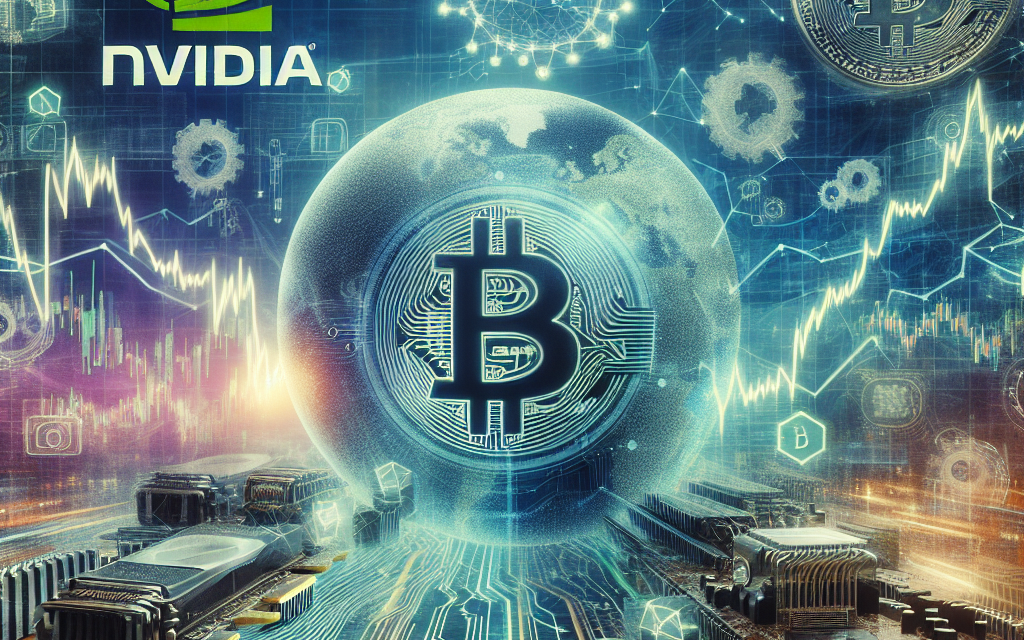“Navigating the Future: Nvidia’s Quantum Leap, Bitcoin’s Wild Ride, and the Trump Trade’s Market Pulse.”
Introduction
Nvidia, a leading technology company renowned for its graphics processing units (GPUs), has become a pivotal player in the realm of quantum computing, driving advancements that enhance computational power and efficiency. As the cryptocurrency landscape evolves, Bitcoin volatility remains a significant concern for investors, influenced by market sentiment, regulatory developments, and macroeconomic factors. Additionally, the “Trump Trade” refers to market movements and investment strategies that emerged during Donald Trump’s presidency, characterized by shifts in sectors such as energy, finance, and infrastructure. This recap provides insights into these interconnected themes, highlighting their implications for investors navigating the complex financial landscape.
Nvidia’s Role in Advancing Quantum Computing
Nvidia has emerged as a pivotal player in the realm of quantum computing, leveraging its advanced graphics processing units (GPUs) to facilitate breakthroughs in this cutting-edge field. As the demand for computational power continues to escalate, Nvidia’s innovative technologies are increasingly being recognized for their potential to enhance quantum algorithms and simulations. The company’s GPUs, known for their parallel processing capabilities, are particularly well-suited for the complex calculations required in quantum computing. This synergy between traditional computing and quantum mechanics is fostering a new era of technological advancement, where Nvidia’s contributions are becoming indispensable.
Moreover, Nvidia’s commitment to research and development in quantum computing is evident through its strategic partnerships and investments. By collaborating with leading academic institutions and research organizations, Nvidia is not only advancing its own technological capabilities but also contributing to the broader scientific community’s understanding of quantum phenomena. These partnerships are crucial, as they enable the sharing of knowledge and resources, ultimately accelerating the pace of innovation. As a result, Nvidia is positioning itself at the forefront of a rapidly evolving landscape, where the intersection of classical and quantum computing holds immense promise for various applications, including cryptography, optimization problems, and artificial intelligence.
In addition to its technological advancements, Nvidia’s role in the quantum computing sector is also influenced by the growing interest in cryptocurrencies, particularly Bitcoin. The volatility of Bitcoin has captured the attention of investors and technologists alike, prompting discussions about the potential of quantum computing to disrupt traditional cryptographic methods. As Bitcoin relies on complex algorithms for security, the advent of quantum computing could pose significant challenges to its underlying infrastructure. This potential threat has spurred a sense of urgency within the cryptocurrency community to explore quantum-resistant algorithms, thereby highlighting the importance of Nvidia’s contributions to the development of robust quantum technologies.
Furthermore, the interplay between Nvidia’s advancements in quantum computing and the broader financial markets cannot be overlooked. The so-called “Trump trade,” characterized by market fluctuations influenced by political developments, has created an environment where technology stocks, including Nvidia, are particularly sensitive to investor sentiment. As market participants react to news and policy changes, Nvidia’s stock performance often reflects broader trends in technology and innovation. This dynamic underscores the importance of understanding the implications of quantum computing not only for technological progress but also for its potential impact on market behavior.
As Nvidia continues to push the boundaries of what is possible in quantum computing, the implications for various sectors are profound. Industries ranging from finance to healthcare stand to benefit from the enhanced computational capabilities that quantum technologies promise. The ability to solve complex problems at unprecedented speeds could lead to breakthroughs in drug discovery, financial modeling, and supply chain optimization, among other areas. Consequently, Nvidia’s role in advancing quantum computing is not merely a technological endeavor; it is a transformative force that could reshape entire industries.
In conclusion, Nvidia’s contributions to quantum computing are multifaceted, encompassing technological innovation, strategic partnerships, and implications for financial markets. As the company continues to explore the potential of quantum technologies, its influence will likely extend beyond the realm of computing, impacting various sectors and shaping the future of technology and finance. The intersection of Nvidia’s advancements with the volatility of Bitcoin and the dynamics of the Trump trade further illustrates the interconnectedness of these themes, highlighting the importance of staying informed in an ever-evolving landscape.
Understanding Bitcoin Volatility: Causes and Effects
Bitcoin volatility is a phenomenon that has captured the attention of investors, analysts, and the general public alike. Understanding the causes and effects of this volatility is crucial for anyone looking to navigate the complex landscape of cryptocurrency investments. At its core, Bitcoin’s price fluctuations can be attributed to a variety of factors, including market sentiment, regulatory developments, technological advancements, and macroeconomic trends.
One of the primary drivers of Bitcoin’s volatility is market sentiment, which can shift rapidly based on news events or social media trends. For instance, a positive announcement regarding institutional adoption or a major company integrating Bitcoin into its payment system can lead to a surge in demand, driving prices upward. Conversely, negative news, such as regulatory crackdowns or security breaches, can trigger panic selling, resulting in sharp declines. This sensitivity to news is exacerbated by the relatively low market capitalization of Bitcoin compared to traditional assets, meaning that even small amounts of capital can significantly influence price movements.
In addition to market sentiment, regulatory developments play a pivotal role in shaping Bitcoin’s volatility. Governments around the world are still grappling with how to regulate cryptocurrencies, and their decisions can have immediate and profound effects on the market. For example, when China announced a crackdown on cryptocurrency mining and trading, Bitcoin’s price plummeted as investors reacted to the potential for reduced demand from one of the largest markets. Similarly, news of regulatory approval or favorable legislation in other regions can lead to price surges, as investors perceive a more stable environment for cryptocurrency investments.
Technological advancements also contribute to Bitcoin’s volatility. The cryptocurrency space is characterized by rapid innovation, with new technologies and platforms emerging regularly. Developments such as the Lightning Network, which aims to improve transaction speeds and reduce costs, can enhance Bitcoin’s utility and attractiveness as a payment method. However, technological challenges, such as scalability issues or security vulnerabilities, can lead to uncertainty and price fluctuations. As investors weigh the potential benefits of new technologies against the risks, Bitcoin’s price can experience significant swings.
Moreover, macroeconomic trends have a substantial impact on Bitcoin’s volatility. Factors such as inflation rates, interest rates, and geopolitical tensions can influence investor behavior and risk appetite. For instance, during periods of economic uncertainty, some investors may turn to Bitcoin as a hedge against inflation or currency devaluation, driving up demand and prices. Conversely, when traditional markets are performing well, investors may be less inclined to allocate funds to cryptocurrencies, leading to decreased demand and potential price declines.
The effects of Bitcoin’s volatility extend beyond individual investors; they can also impact broader financial markets. As Bitcoin gains prominence, its price movements can influence the performance of related assets, such as stocks of companies involved in cryptocurrency mining or blockchain technology. Additionally, the rise of Bitcoin derivatives and exchange-traded products has created a more interconnected financial ecosystem, where Bitcoin’s volatility can spill over into traditional markets, leading to increased correlations between asset classes.
In conclusion, understanding Bitcoin volatility requires a multifaceted approach that considers market sentiment, regulatory developments, technological advancements, and macroeconomic trends. Each of these factors interacts in complex ways, contributing to the cryptocurrency’s unpredictable price movements. As the market continues to evolve, investors must remain vigilant and informed, recognizing that while Bitcoin presents unique opportunities, it also carries inherent risks that can lead to significant financial consequences.
The Trump Trade: Analyzing Market Reactions
The Trump Trade has emerged as a significant phenomenon in the financial markets, characterized by the volatility and unpredictability that often accompany political developments. As former President Donald Trump continues to influence the political landscape, investors are keenly attuned to the implications of his actions and statements on market dynamics. This phenomenon is particularly evident in sectors such as technology, energy, and healthcare, where policy changes can lead to rapid shifts in stock prices. For instance, Trump’s administration was marked by deregulation efforts that buoyed certain industries, leading to a surge in stock valuations. Consequently, investors began to anticipate similar outcomes in response to his ongoing political maneuvers, creating a cycle of speculation that drives market reactions.
Moreover, the Trump Trade is not solely confined to traditional equities; it also extends to commodities and cryptocurrencies. The latter, particularly Bitcoin, has experienced notable fluctuations in response to Trump’s commentary on digital currencies. His tweets and public statements often trigger immediate reactions in the crypto market, reflecting the heightened sensitivity of this asset class to external influences. As Bitcoin continues to gain traction as a legitimate investment vehicle, the interplay between political rhetoric and market sentiment becomes increasingly pronounced. Investors must navigate this landscape with caution, as the volatility associated with the Trump Trade can lead to both opportunities and risks.
Transitioning from the broader implications of the Trump Trade, it is essential to consider how market participants are adapting their strategies in light of these developments. Many investors are employing a more reactive approach, closely monitoring news cycles and political events to inform their trading decisions. This shift towards a more dynamic investment strategy underscores the importance of agility in today’s market environment. Furthermore, the rise of algorithmic trading has amplified the speed at which markets respond to political news, creating a feedback loop that can exacerbate volatility. As a result, understanding the nuances of the Trump Trade has become crucial for investors seeking to capitalize on short-term price movements.
In addition to the immediate market reactions, the Trump Trade also raises questions about the long-term implications for economic policy and market stability. The potential for policy reversals or shifts in regulatory frameworks can create uncertainty, prompting investors to reassess their positions. This uncertainty is particularly relevant in sectors that are heavily influenced by government policy, such as healthcare and renewable energy. As investors grapple with these complexities, the need for comprehensive analysis and strategic foresight becomes paramount.
Furthermore, the interplay between the Trump Trade and broader economic indicators cannot be overlooked. For instance, changes in interest rates, inflation expectations, and employment data can all influence market sentiment and investor behavior. As such, the Trump Trade exists within a larger context of economic forces that shape market dynamics. Investors must remain vigilant, recognizing that while political developments can create immediate opportunities, they are often intertwined with fundamental economic trends.
In conclusion, the Trump Trade represents a multifaceted aspect of market behavior that reflects the intricate relationship between politics and finance. As investors navigate this landscape, they must remain adaptable and informed, recognizing the potential for both volatility and opportunity. By understanding the underlying factors that drive market reactions, investors can better position themselves to respond to the ever-evolving dynamics of the financial markets.
Nvidia’s Impact on Cryptocurrency Mining Efficiency
Nvidia has emerged as a pivotal player in the realm of cryptocurrency mining, significantly influencing the efficiency and profitability of this sector. As the demand for cryptocurrencies continues to surge, the need for powerful computing resources has become increasingly critical. Nvidia’s graphics processing units (GPUs) have gained prominence due to their exceptional performance in handling the complex calculations required for mining various cryptocurrencies, particularly Bitcoin and Ethereum. This has led to a notable shift in the mining landscape, where miners are now seeking to optimize their operations through the adoption of advanced technology.
The efficiency of Nvidia’s GPUs is largely attributed to their parallel processing capabilities, which allow them to perform multiple calculations simultaneously. This feature is particularly advantageous in cryptocurrency mining, where the ability to solve cryptographic puzzles quickly can lead to higher rewards. As a result, miners equipped with Nvidia GPUs can achieve greater hash rates, thereby increasing their chances of successfully mining new blocks and earning cryptocurrency rewards. This technological edge has not only enhanced individual miners’ profitability but has also contributed to the overall competitiveness of the mining industry.
Moreover, Nvidia’s commitment to innovation has led to the development of specialized hardware tailored for cryptocurrency mining. The introduction of dedicated mining GPUs has further optimized energy consumption and performance, addressing one of the most pressing concerns in the mining community: the environmental impact of energy-intensive mining operations. By providing more efficient solutions, Nvidia is helping miners reduce their carbon footprint while maintaining profitability, which is increasingly important in a world that is becoming more environmentally conscious.
In addition to improving mining efficiency, Nvidia’s influence extends to the broader cryptocurrency market. As miners adopt more efficient technologies, the overall supply dynamics of cryptocurrencies can shift. For instance, increased mining efficiency can lead to a higher rate of new coin generation, which may impact market prices. This interplay between mining efficiency and market dynamics is crucial for investors and stakeholders in the cryptocurrency ecosystem, as it can create volatility and influence trading strategies.
Furthermore, the relationship between Nvidia’s advancements and Bitcoin volatility cannot be overlooked. As miners respond to changes in technology and market conditions, their actions can lead to fluctuations in Bitcoin’s price. For example, if a significant number of miners upgrade to Nvidia’s latest GPUs, the increased hash rate could lead to a more competitive mining environment. This heightened competition may result in a temporary oversupply of Bitcoin, potentially driving prices down. Conversely, if mining becomes less profitable due to rising energy costs or regulatory challenges, miners may exit the market, leading to a decrease in supply and a subsequent price increase.
In conclusion, Nvidia’s impact on cryptocurrency mining efficiency is profound and multifaceted. By providing cutting-edge technology that enhances performance and reduces energy consumption, Nvidia is not only shaping the future of mining but also influencing the broader cryptocurrency market. As miners continue to adapt to these advancements, the interplay between mining efficiency and market dynamics will remain a critical area of focus for investors and analysts alike. Understanding this relationship is essential for navigating the complexities of the cryptocurrency landscape, particularly in an environment characterized by rapid technological change and market volatility. As the industry evolves, Nvidia’s role will undoubtedly continue to be a significant factor in shaping the future of cryptocurrency mining and its associated markets.
Quantum Computing’s Potential to Disrupt Financial Markets
Quantum computing represents a transformative leap in computational power, with the potential to disrupt various sectors, including financial markets. As traditional computing approaches its limits, quantum technology offers a new paradigm that could revolutionize how financial institutions analyze data, manage risk, and execute trades. The implications of this shift are profound, particularly in an era where speed and accuracy are paramount in trading environments.
To begin with, quantum computers operate on principles of quantum mechanics, allowing them to process vast amounts of data simultaneously. This capability could enable financial analysts to run complex simulations and models that are currently infeasible with classical computers. For instance, portfolio optimization, which involves selecting the best mix of assets to maximize returns while minimizing risk, could be executed with unprecedented efficiency. By leveraging quantum algorithms, financial firms could identify optimal investment strategies in real-time, thereby enhancing their competitive edge.
Moreover, the ability of quantum computing to solve problems that are currently intractable could lead to significant advancements in risk management. Financial institutions often grapple with the challenge of assessing and mitigating risks associated with market volatility, credit exposure, and operational failures. Quantum computing could facilitate more accurate risk assessments by enabling firms to analyze multiple variables and scenarios simultaneously. This enhanced analytical capability would not only improve decision-making but also contribute to greater stability within the financial system.
In addition to risk management, quantum computing could also transform trading strategies. High-frequency trading, which relies on executing a large number of orders at extremely high speeds, could benefit immensely from quantum algorithms. These algorithms could analyze market data and execute trades in fractions of a second, capitalizing on fleeting opportunities that traditional systems might miss. As a result, firms that adopt quantum technology may gain a significant advantage in the increasingly competitive trading landscape.
However, the rise of quantum computing also poses challenges, particularly concerning security. The cryptographic protocols that underpin current financial transactions may become vulnerable to quantum attacks, necessitating a reevaluation of cybersecurity measures. Financial institutions must proactively develop quantum-resistant encryption methods to safeguard sensitive data and maintain trust in the integrity of their systems. This need for enhanced security measures underscores the dual-edged nature of technological advancement; while quantum computing offers remarkable opportunities, it also introduces new risks that must be managed effectively.
Furthermore, the integration of quantum computing into financial markets could lead to shifts in market dynamics. As firms adopt this technology, the speed and efficiency of trading could increase, potentially leading to greater market volatility. The interplay between quantum-enhanced trading strategies and traditional methods may create a new landscape where market behaviors are influenced by the capabilities of quantum algorithms. Consequently, market participants will need to adapt to these changes, developing new strategies to navigate an evolving environment.
In conclusion, the potential of quantum computing to disrupt financial markets is immense, offering opportunities for enhanced data analysis, improved risk management, and accelerated trading strategies. However, this technological advancement also brings challenges, particularly in terms of security and market dynamics. As financial institutions begin to explore the capabilities of quantum technology, they must balance the benefits with the associated risks, ensuring that they are well-prepared for the future of finance in a quantum world. The journey toward this new frontier will undoubtedly shape the landscape of financial markets for years to come.
Strategies for Navigating Bitcoin’s Price Fluctuations
Navigating the volatile landscape of Bitcoin requires a strategic approach, particularly in light of the cryptocurrency’s propensity for dramatic price fluctuations. Investors must first understand the underlying factors that contribute to these price movements. Market sentiment, regulatory developments, and macroeconomic indicators all play significant roles in shaping Bitcoin’s value. For instance, news regarding regulatory crackdowns or endorsements can lead to swift price changes, making it essential for investors to stay informed about the latest developments in the cryptocurrency space.
One effective strategy for managing Bitcoin’s volatility is the implementation of dollar-cost averaging (DCA). This approach involves investing a fixed amount of money at regular intervals, regardless of the asset’s price. By doing so, investors can mitigate the impact of short-term price swings and reduce the risk of making poor investment decisions based on emotional reactions to market fluctuations. Over time, DCA can lead to a more favorable average purchase price, allowing investors to build their positions in Bitcoin without the stress of trying to time the market.
In addition to DCA, diversification remains a crucial strategy for navigating Bitcoin’s price volatility. By spreading investments across various asset classes, including stocks, bonds, and other cryptocurrencies, investors can reduce their overall risk exposure. This approach not only helps to cushion the impact of Bitcoin’s price swings but also allows investors to capitalize on potential gains in other areas of their portfolios. Furthermore, incorporating assets that have a low correlation with Bitcoin can enhance overall portfolio stability, providing a buffer during periods of heightened volatility.
Another important consideration for investors is the use of stop-loss orders. These orders automatically sell a specified amount of Bitcoin when its price falls to a predetermined level, thereby limiting potential losses. While stop-loss orders can be an effective risk management tool, it is essential for investors to set their thresholds thoughtfully. Setting stop-loss levels too close to the current price may result in premature selling during temporary dips, while levels set too far away may expose investors to larger losses. Therefore, careful analysis and consideration of market conditions are necessary when determining appropriate stop-loss levels.
Moreover, staying abreast of technological advancements and market trends can provide valuable insights for navigating Bitcoin’s volatility. For instance, developments in quantum computing may have implications for the security and efficiency of blockchain technology, potentially influencing Bitcoin’s long-term viability. As such, investors should remain vigilant about emerging technologies and their potential impact on the cryptocurrency market.
Lastly, maintaining a long-term perspective is vital when dealing with Bitcoin’s price fluctuations. While short-term trading can be tempting, it often leads to increased stress and emotional decision-making. By focusing on long-term goals and the fundamental value of Bitcoin as a digital asset, investors can better withstand the inevitable ups and downs of the market. This approach encourages a disciplined investment strategy, allowing individuals to ride out periods of volatility while remaining committed to their overall investment objectives.
In conclusion, successfully navigating Bitcoin’s price fluctuations requires a combination of informed strategies, including dollar-cost averaging, diversification, and the use of stop-loss orders. By staying informed about market developments and maintaining a long-term perspective, investors can better manage the inherent risks associated with Bitcoin and position themselves for potential future gains. Ultimately, a thoughtful and disciplined approach will serve as a foundation for success in the ever-evolving cryptocurrency landscape.
The Intersection of Nvidia Technology and Market Trends
Nvidia has emerged as a pivotal player in the technology sector, particularly with its advancements in graphics processing units (GPUs) and artificial intelligence (AI). The company’s innovations have not only transformed the gaming industry but have also significantly influenced various sectors, including data centers, automotive technology, and, notably, quantum computing. As businesses increasingly seek to harness the power of AI and machine learning, Nvidia’s GPUs have become essential tools for processing vast amounts of data efficiently. This growing demand for high-performance computing has positioned Nvidia at the forefront of technological evolution, making it a key indicator of broader market trends.
In recent years, the intersection of Nvidia’s technology and market dynamics has become increasingly pronounced. For instance, the rise of quantum computing represents a frontier that Nvidia is keen to explore. Quantum computing promises to revolutionize problem-solving capabilities, particularly in fields such as cryptography, materials science, and complex system modeling. Nvidia’s commitment to developing software and hardware that can support quantum computing initiatives reflects its strategic vision to remain relevant in an ever-evolving technological landscape. As companies invest in quantum technologies, Nvidia’s role as a facilitator of this transition could further solidify its market position and influence.
Moreover, the volatility of Bitcoin and other cryptocurrencies has added another layer of complexity to the market landscape. The demand for GPUs has surged in tandem with the cryptocurrency mining boom, as miners require powerful hardware to solve complex mathematical problems and validate transactions. However, the fluctuating prices of Bitcoin have led to unpredictable demand for Nvidia’s products. When Bitcoin prices soar, the demand for GPUs spikes, but when prices plummet, the market can experience a sharp decline in sales. This cyclical nature of cryptocurrency volatility presents both opportunities and challenges for Nvidia, as it navigates the delicate balance between meeting immediate market needs and planning for long-term growth.
In addition to these technological and market dynamics, the political landscape, particularly the influence of figures like Donald Trump, has also played a role in shaping market trends. The so-called “Trump Trade” refers to the market’s reaction to policies and statements made during his presidency, which often led to significant fluctuations in stock prices across various sectors. Nvidia, being a publicly traded company, was not immune to these influences. Changes in trade policies, tariffs, and regulatory environments can impact Nvidia’s supply chain and market access, thereby affecting its stock performance. Investors closely monitor these developments, as they can create both risks and opportunities for the company.
As we look ahead, the intersection of Nvidia’s technology with market trends will likely continue to evolve. The company’s ongoing investments in AI and quantum computing, coupled with the unpredictable nature of cryptocurrency markets and the influence of political factors, will shape its trajectory. Investors and industry observers must remain vigilant, as these elements intertwine to create a complex tapestry of opportunities and challenges. Ultimately, Nvidia’s ability to adapt to these changing dynamics will be crucial in determining its future success and its role in the broader technology landscape. As such, understanding these intersections will be essential for anyone looking to navigate the intricacies of the modern market.
Q&A
1. **What is Nvidia’s role in the AI market?**
Nvidia is a leading provider of GPUs that are essential for AI training and inference, making it a key player in the AI industry.
2. **How is quantum computing expected to impact industries?**
Quantum computing has the potential to revolutionize industries by solving complex problems faster than classical computers, impacting fields like cryptography, drug discovery, and optimization.
3. **What factors contribute to Bitcoin’s volatility?**
Bitcoin’s volatility is influenced by market sentiment, regulatory news, macroeconomic trends, and the relatively low liquidity compared to traditional assets.
4. **What is the “Trump Trade”?**
The “Trump Trade” refers to market movements and investment strategies that were influenced by policies and announcements made during Donald Trump’s presidency, particularly in sectors like infrastructure and defense.
5. **How has Nvidia’s stock performed recently?**
Nvidia’s stock has seen significant gains due to strong demand for its GPUs driven by AI and data center growth.
6. **What are the current challenges facing quantum computing development?**
Challenges include error rates in quantum bits (qubits), the need for better algorithms, and the high cost of maintaining quantum systems.
7. **What strategies can investors use to navigate Bitcoin’s volatility?**
Investors can use strategies such as dollar-cost averaging, diversification, and setting stop-loss orders to manage risk associated with Bitcoin’s price fluctuations.
Conclusion
Nvidia’s advancements in AI and GPU technology position it as a leader in the tech sector, while the growing interest in quantum computing suggests a transformative future for data processing and cryptography. Bitcoin’s volatility continues to reflect broader market uncertainties and regulatory challenges, impacting investor sentiment. The “Trump Trade” highlights the influence of political developments on market dynamics, particularly in sectors like energy and defense. Overall, these factors illustrate the interconnectedness of technology, finance, and politics in shaping market trends and investor strategies.





